# 26 Umbria's Remarkable Hilltop Towns: The Consolation of Old Stone
On chasing frescos and rediscovering slow life
After two months of living high above a lake (and beneath two clamorous senior sisters), Daniel and I leave Bracciano and its imposing castle and head to yet another fortified town. Something in the stone and structure of these places must attract me, yet I cannot quite figure out what it is. Do I sense safety? A promise of permanence? The hold of a small community?
We board a train south to Rome and another north toward Perugia. The slow regional trains depart with reliable delay and are busy with chatting commuters. We get off at the bare, single-platform station in Spello with only a bit of daylight left. It’s late November and night starts around 5 in the afternoon.
After two waiting cars have picked up the passengers that disembarked with us, Daniel and I find ourselves alone. Our kind AirBnB host has offered to reserve us a taxi—the only one in town—but we want to leg it, twenty minutes uphill. We take pride in our mobility and independence. It’s why we travel light, with one medium and one small backpack each. We also take pride in cutting costs.
The one deserted street toward the old town of Spello is darkened by trees. We don’t see the German shepherd locked behind a gate until we’re almost on top of him. He barks at us aggressively—not the most warming welcome—but as soon as we’ve passed underneath the highway, the town opens up to us. There it is, Porta Consolare, the first of Spello’s six ancient gates.
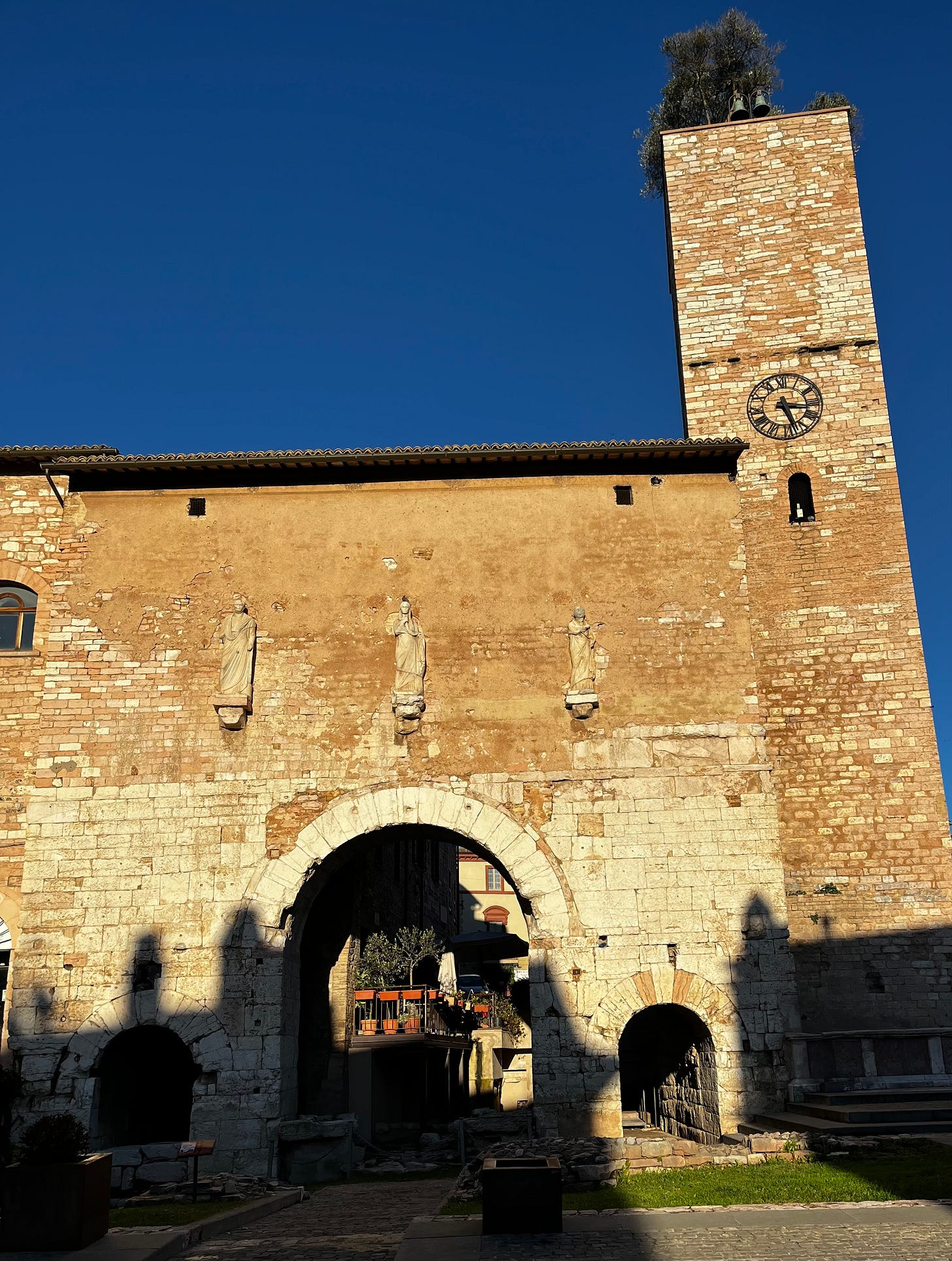
Spello, in the shadow of Mount Subasio, is one of the oldest towns in the region. It was founded by the Umbri, contemporaries of the Etruscans, but there are few traces of the Umbri left. The Romans, on the other hand, who named the town Hispellum, built gates and mosaic floors that can still be admired today.
The sky falls into darkness as we climb. Shops and restaurants light up the winding road. Roasted pork here, truffle sauce there, and wine everywhere. The pretty town is catering to visitors without being overly touristic, and seems well-cared for. There’s no garbage on the streets, no scaffolding, no graffiti. The limestone buildings are soft yellow blushed with rose.
Daniel and I are shivering on our walk into town. Winter in Italy arrived this afternoon and we’re shamefully underdressed. The downside of traveling light is that we cannot carry clothes with us for all seasons. We could have prepared ourselves better by buying winter gear in a secondhand store (as we did when heading to the Japanese Alps), but we decided against it because our time in the cold would be so short: Soon we’re flying to the tropics of South America via sunny Florida and California and we won’t need these extra clothes. So we layered up with everything we got and hoped for the best.
When we pass a church with its doors wide open, we step inside—we know from experience that doors are often closed when you don’t want them to be and so we seize opportunities when they arise. Even if that means surrendering to art briefly with your luggage on your back. I will later learn that the frescos in Chiesa di Sant'Andrea are not as famous as the Pintoricchio ones in Santa Maria Maggiore, Spello’s number one attraction, but they’re spectacular nonetheless.
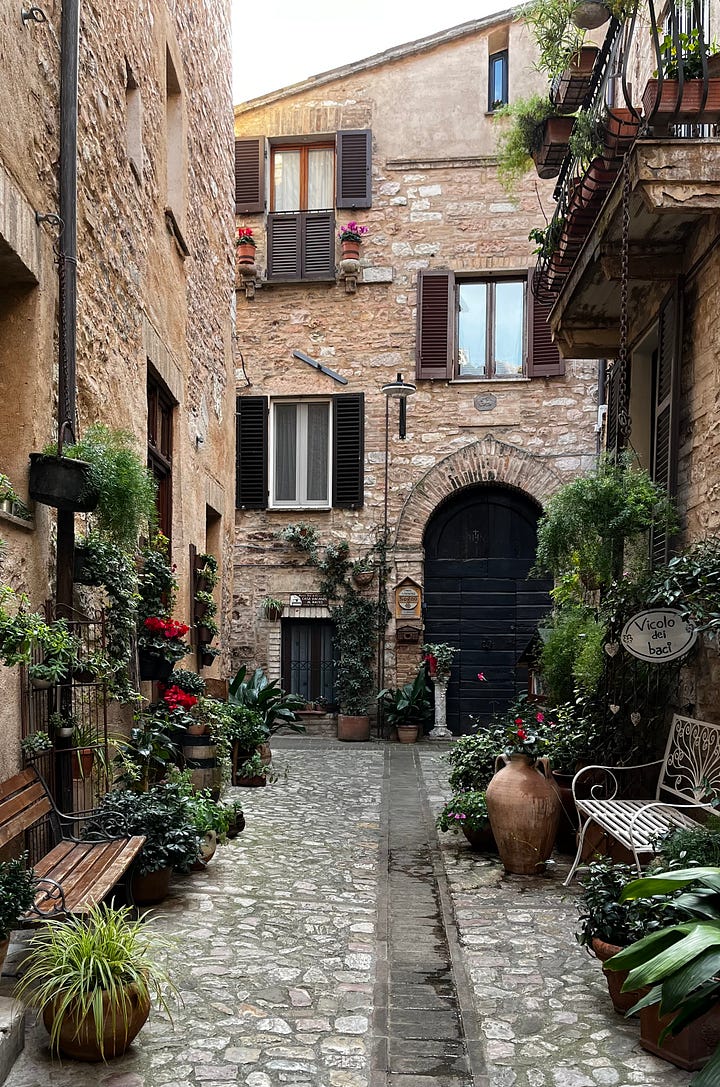
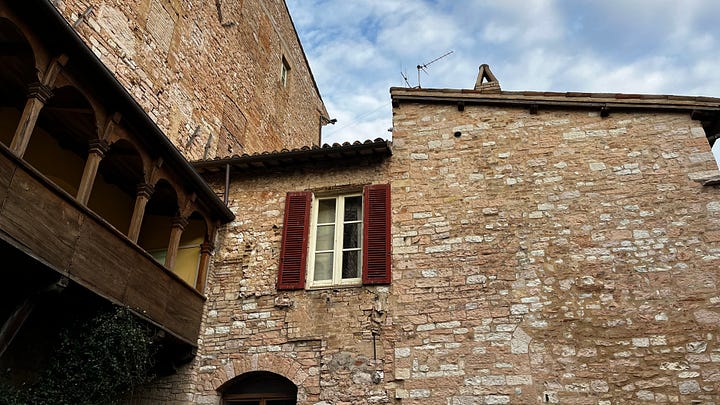
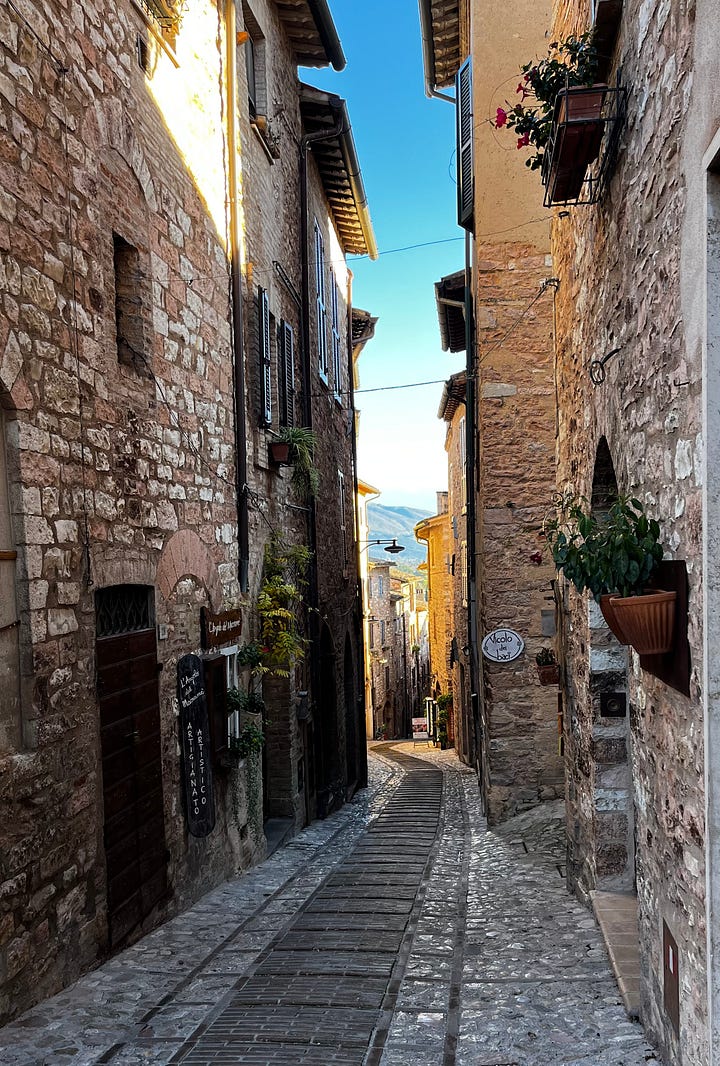
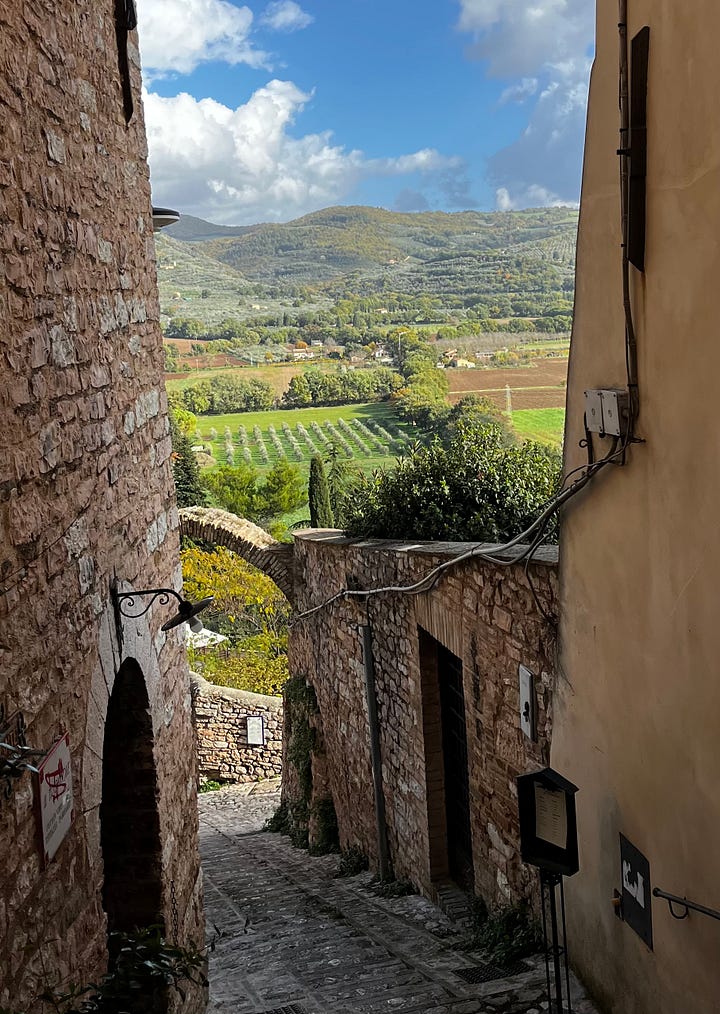
The Stone House
The two-story house we’ve rented for a week is on Via Garibaldi, Spello’s main street. The town is small enough to see on a day trip, but Daniel and I have chosen Spello as our base to explore Umbria. Our entry is in an alley, because the house is right above a clothing store that has its window display and front door on the main street. When we open our old wooden door, it gives directly to a stone staircase instead of a hallway, so we climb to the living room to enter the house.
Inside, it’s predictably cold—old stone houses usually are. Fortunately, there’s a fire place and once we receive a sack of wood from the host, we’re as comfortable as can be with two glasses of local wine in front of the hearth, watching the flames and each other.
In the morning, with my mind damp from sleep, I open the shutters to let in the light. Pigeons have left their droppings everywhere, regardless of whether the window ledges are spiked. People used to encourage pigeons to roost in Umbrian caves, because they were popular birds on the menu. Perhaps tastes have changed: The pigeon population seems to have grown a little out of control.
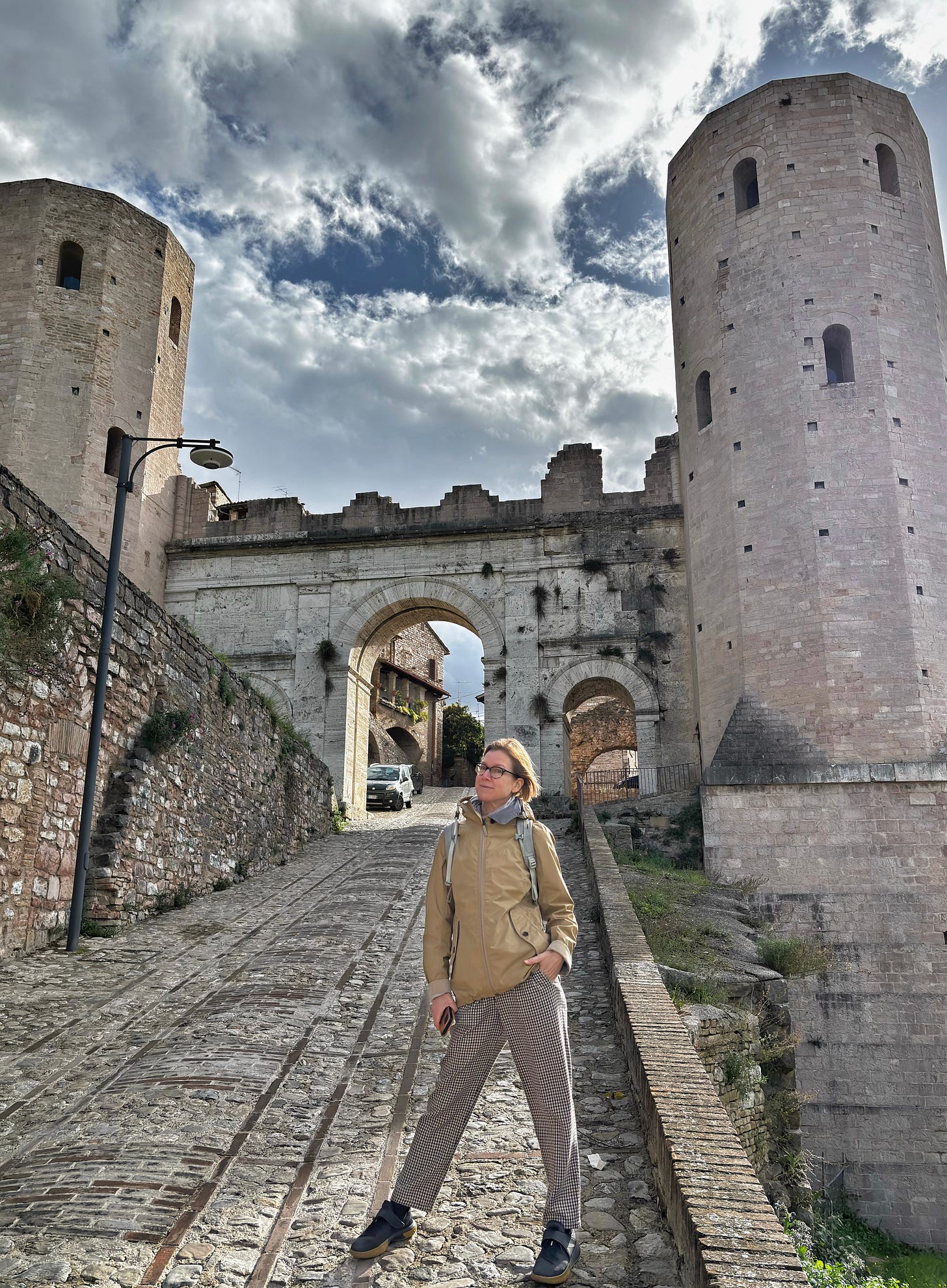
Sightseeing: Spello, Assisi, Spoleto
For the next three days, Daniel and I try to see and do everything I read about in various guides. The stone house is a bit more expensive than our usual accommodations, which I somehow take as an incentive to make the most out of our stay: We must not let a day go to waste.
We tour Spello to photograph the gates. We visit the underwhelming Villa Dei Mosaici—once you’ve seen Pompeii you’re spoiled for good when it comes to Roman mosaic floors. We trek to and then through the dead garden of Villa Fidelia, imagining how lovely the place must be in the spring. And we hop on many delayed trains disconnecting to as many buses.
I cannot deny it: Assisi on a sunny day is stunning. If you’re ever in the region, you must walk these quaint cobblestone streets leading to multiple spectacular churches. The birthplace of Saint Francis, Italy’s patron saint, is one of the world's most popular pilgrimage sites. Five to six million visitors per year gaze at Giotto frescos, and even in November, out of season, it’s a popular place. Daniel and I watch the late afternoon shadows create their own sort of magic and meet with two friends who recently bought a house in Puglia. We wonder: Could we live in Italy, too?
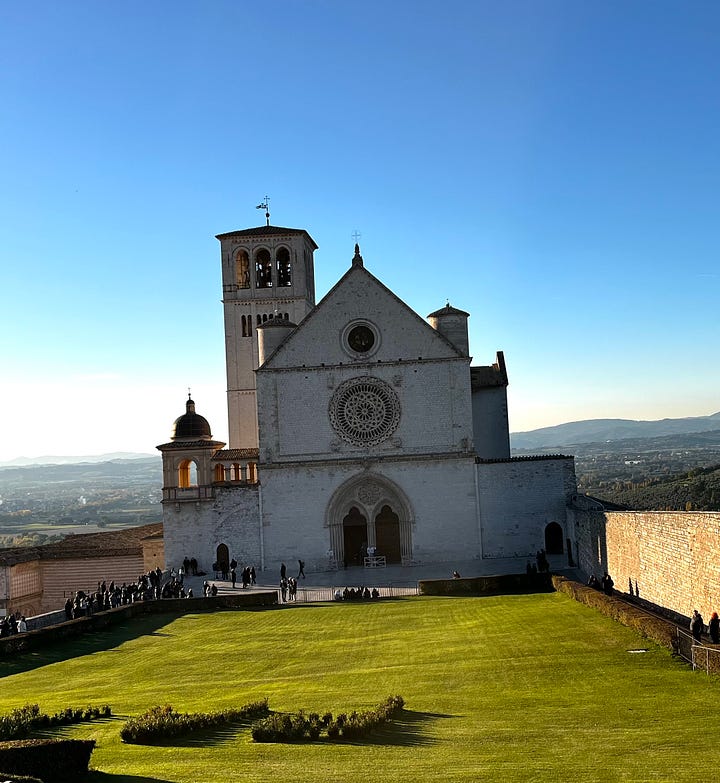
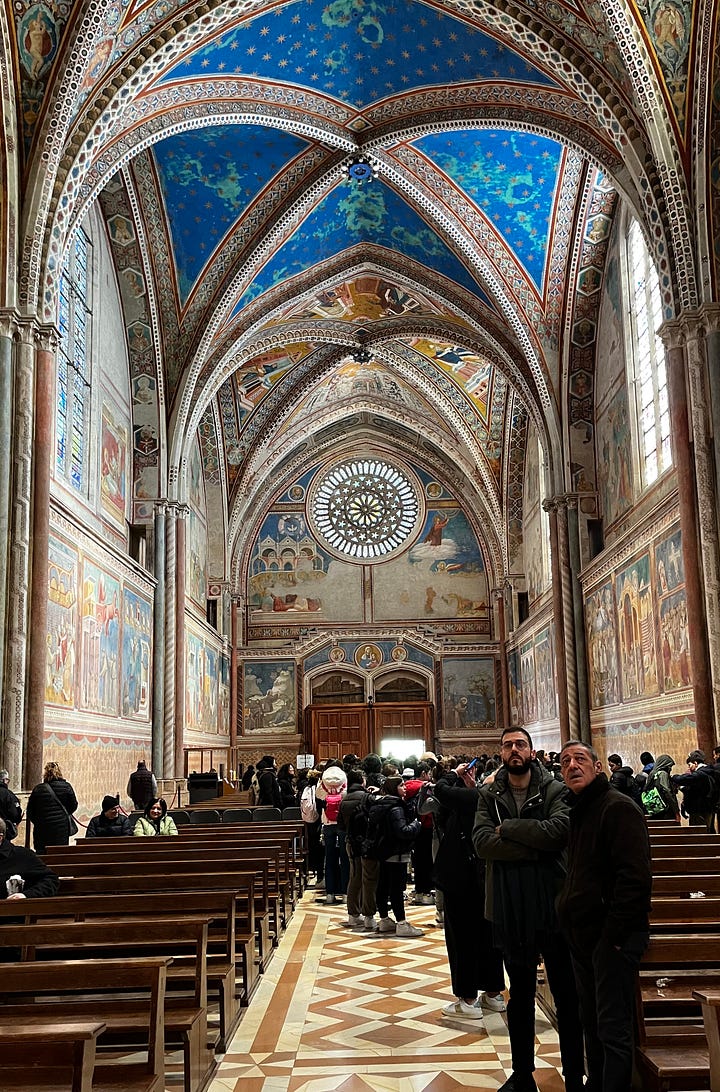
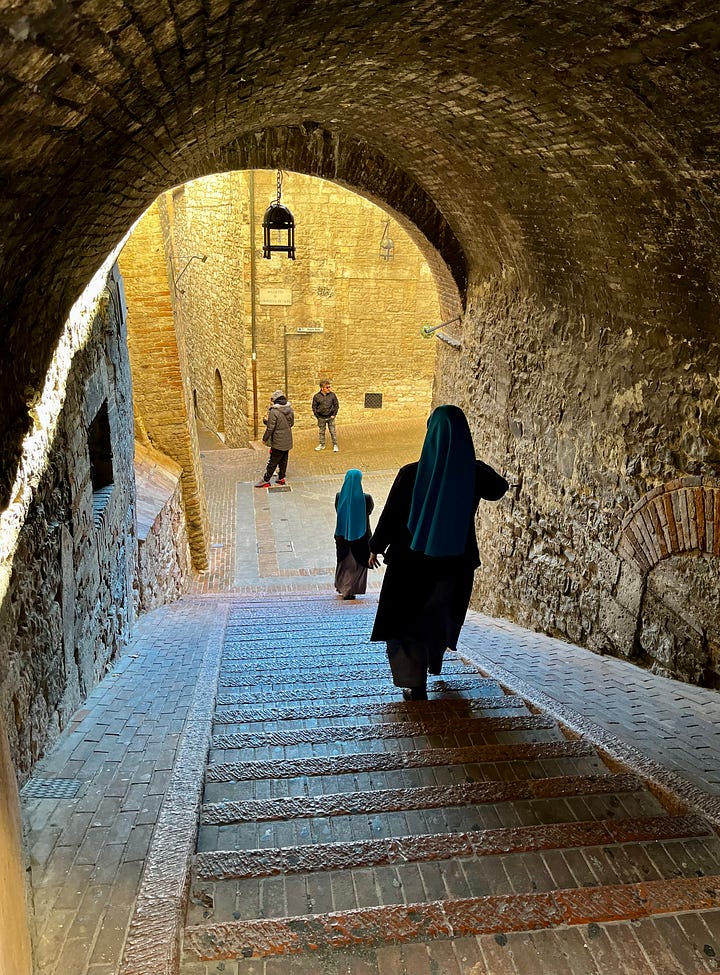
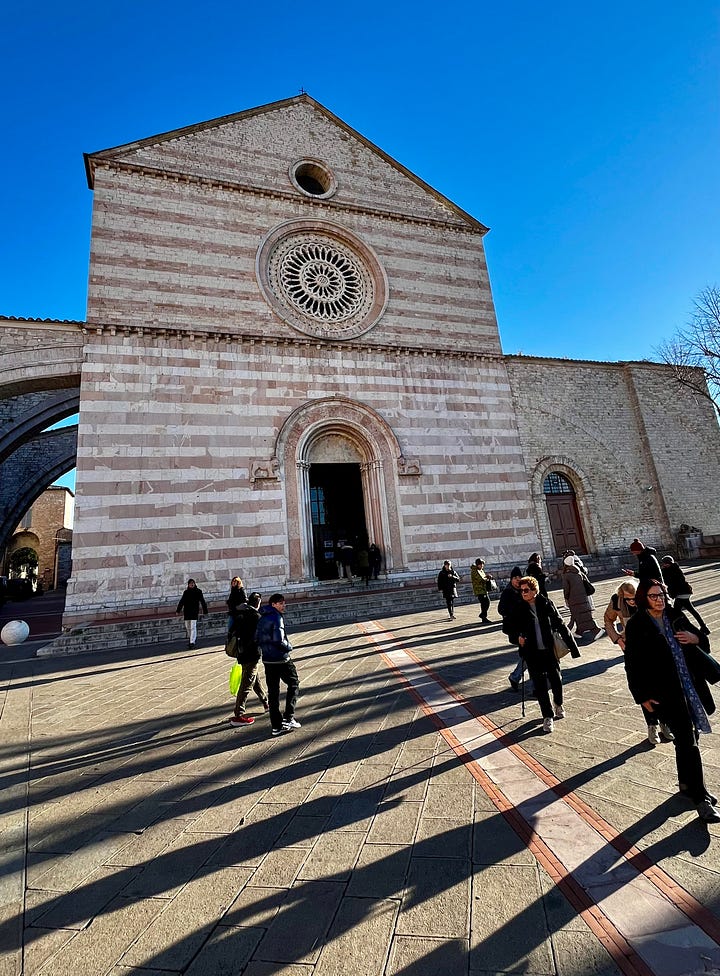
We enter Spoleto on a gloomy November Monday and traipse past shuttered shops, closed restaurants, reconstruction sites, run-down businesses, and for-sale signs. An art fest (Il Festival dei Due Mondi) brings this town to life every summer, but we find little to inspire us until we get on top and take in the fort and the 80m high Roman aqueduct spanning the autumn valley.
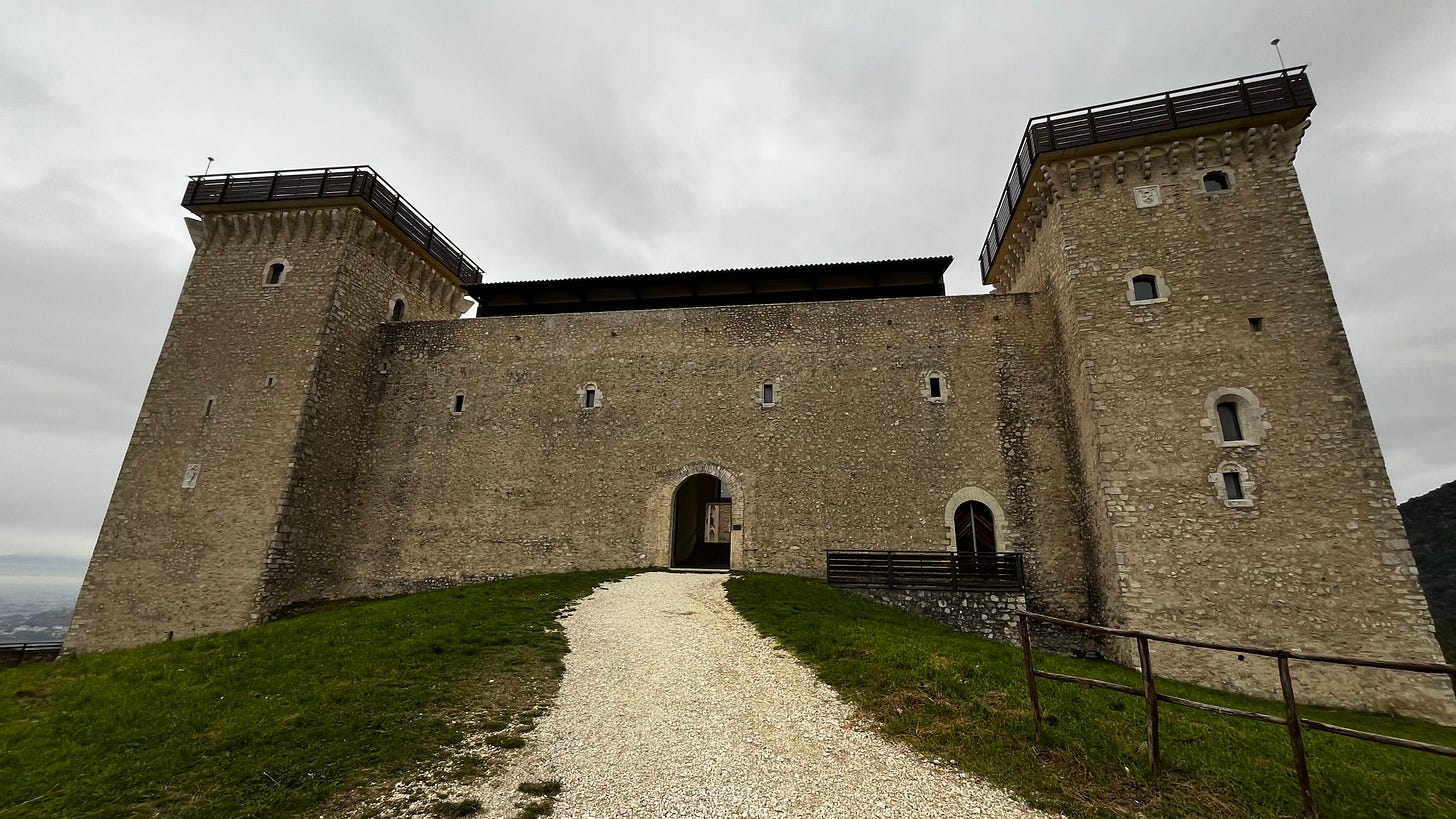
Change of Plans: No Plans
After three days of running around, I come to a stop. We were supposed to visit Gubbio, a known jewel in this region, but the long bus journey there and back doesn’t appeal to me anymore. What’s there to see? Another frescoed church? Another castle? I feel haunted by stress and pressure.
“So what do you want to do instead?” Daniel asks.
I have no answer. I thought I’d wanted to make the most out of our stay and do touristic things like normal people. But I now understand that I didn’t return to Umbria, the place where Daniel and I fell deeply in love, to learn who painted what fresco and why. I didn’t come to trace the history of each Roman gate and map the past. I came to… just be.
So for our last three days in Spello we plan nothing. We move at our own pace, freed from expectations. We write as we linger over our morning coffees. We meander through the pretty streets, buy truffle sauce, listen to live folk music, taste bruschetta (or gluten-free bread) doused in recently pressed local olive oil, sit & read, sit & talk, and sit & gaze. Time unrolls in moments in which life simply happens.
One afternoon, we go for a hike only because we happen to hit upon a wonderful trail and the sun is warm on our backs. There we go, single-file, hushed and unhurried. The 5km path uphill takes us alongside the largely intact Aquedotto Romano and through olive groves where most trees have not yet been picked. The rolling hills are like the ones in Tuscany, with beauty singing in the trees and rosemary lifting the air, and it reminds us why we got married in Italy. There’s nothing to see or do in Collepino, the village where the trail leads us, and that suits us just fine. We fill up our water bottles from the fountain that’s there for hikers like us, turn around, and make our descend.
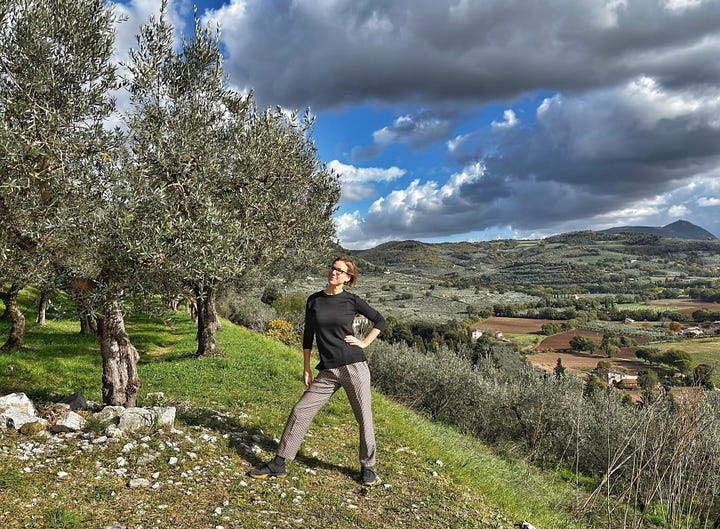
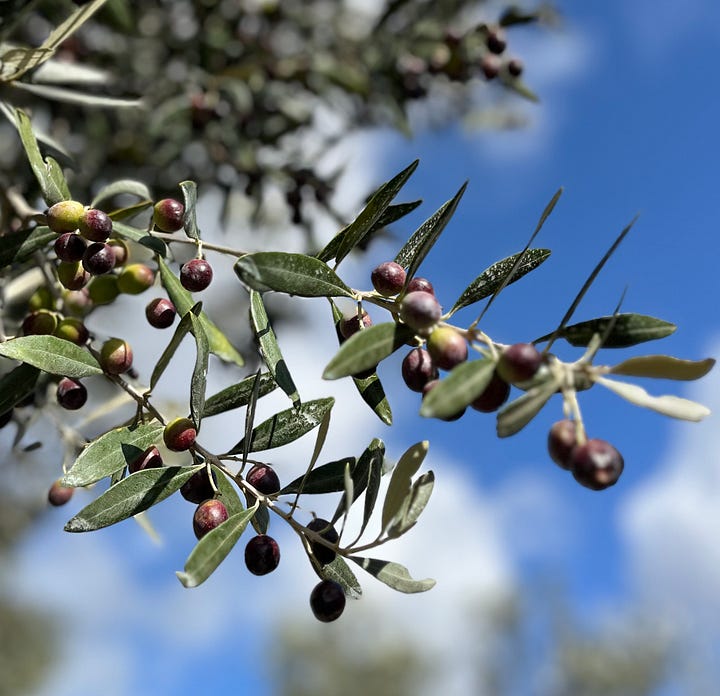
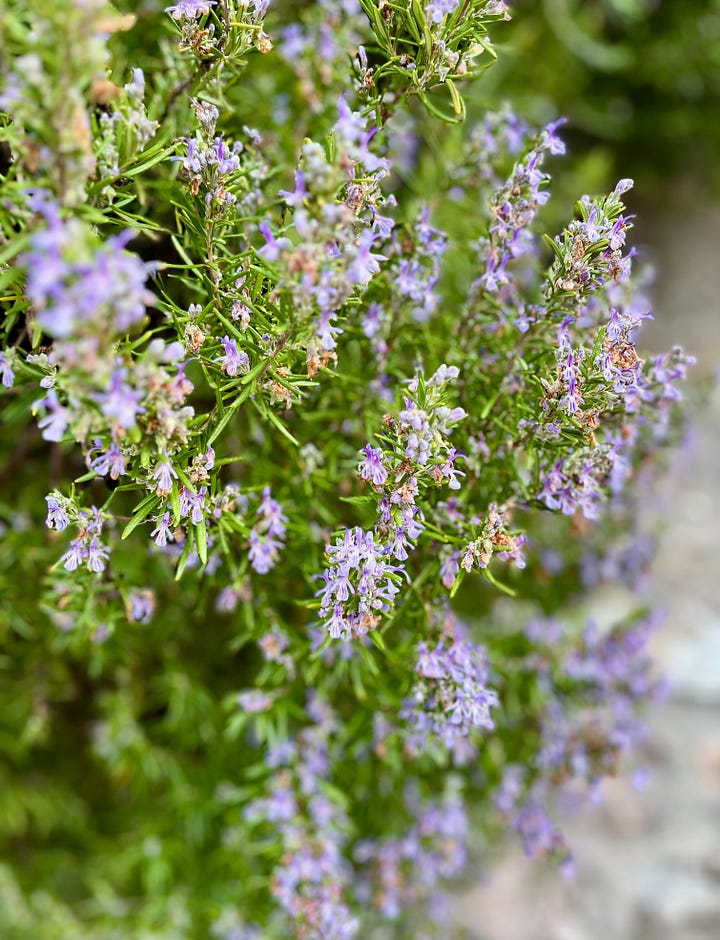
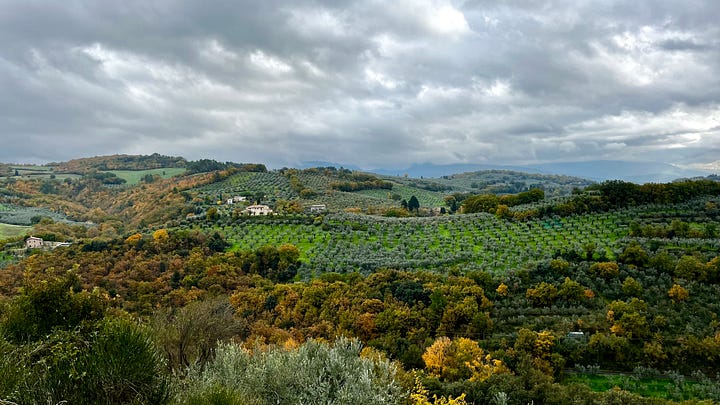
Spello Revisited
When we get back to Spello, the first stars appear over the rooftops, and I feel a sense of home. Enclosed by these old stones, I am protected. Not only from wolves and human invaders, but also from the speed and complexity of the world. Shops close between 1 and 4 in the afternoon, because shopkeepers and employees must eat and enjoy life, too. There are cars in town, yet I’m startled by the rush of pigeon wings more often than by a revved-up motor. At night, we take time to light the fireplace and cook with the wild herbs we harvested that day.
In Spello, I am on pause. So much so, that I lose track of time and accidentally publish my Thanksgiving essay a day early. (Did you notice? Did it make you laugh?) In Spello, I experience the kind of slow life I deeply appreciate and remember how consoling simplicity is. Next time, I will understand why I return here and will come without a plan.
Travel Advice
Public transportation in Umbria exists, but the schedule is not very efficient. Trains are often late, buses can leave early or don’t show up at all, and there are many strikes. So if you want to move around, it may be best to rent a car. (Something we cannot do since neither of us have a valid driver’s license.)
Renting a car will also allow you to stay at an agriturismo, a bed&breakfast on a farm, instead of in a town house or hotel. We did this on other trips to Tuscany and Umbria and it’s a great way to connect with the region. From late summer to mid autumn you can partake in the harvest of grapes—the vendemmia—or the harvest of olives—the raccolta if you stay at an agriturismo.
When coming in the summer or early autumn, be prepared for daytime mosquitos. The aedes aegypti (aka Asian tiger mosquitos) have established themselves in many areas in Italy and they were more of a nuisance for me here than in for example Vietnam.
Gluten-free options are not always on the menu, but when you ask, most restaurants in Italy can make gluten-free dishes. If contamination is an issue, you can look for restaurants that specialize in catering to people with celiac disease. The Associazione Italiana Celiachia (AIC) has a recognizable logo and has a (paid) app in English that tourists can use.
Most towns in Tuscany and Umbria charge a tourism tax of €2 to €8 per person per night. When you make a booking, you may want to check whether this tax is included in the price or will be charged additionally by the host.
Related Posts
If you enjoyed this post, you might also be interested in reading:
Time to Say Goodbye
I was in Florence when I wrote this essay, but will be in the USA when this newsletter goes out. Next week, I’ll travel back to Italy in my mind to tell you how we liked Florence in the off-season.
All my best,
Claire
P.S. By recommending, sharing, liking, and commenting, you will draw more readers to my work. And I truly welcome your feedback. I’m grateful for your support.





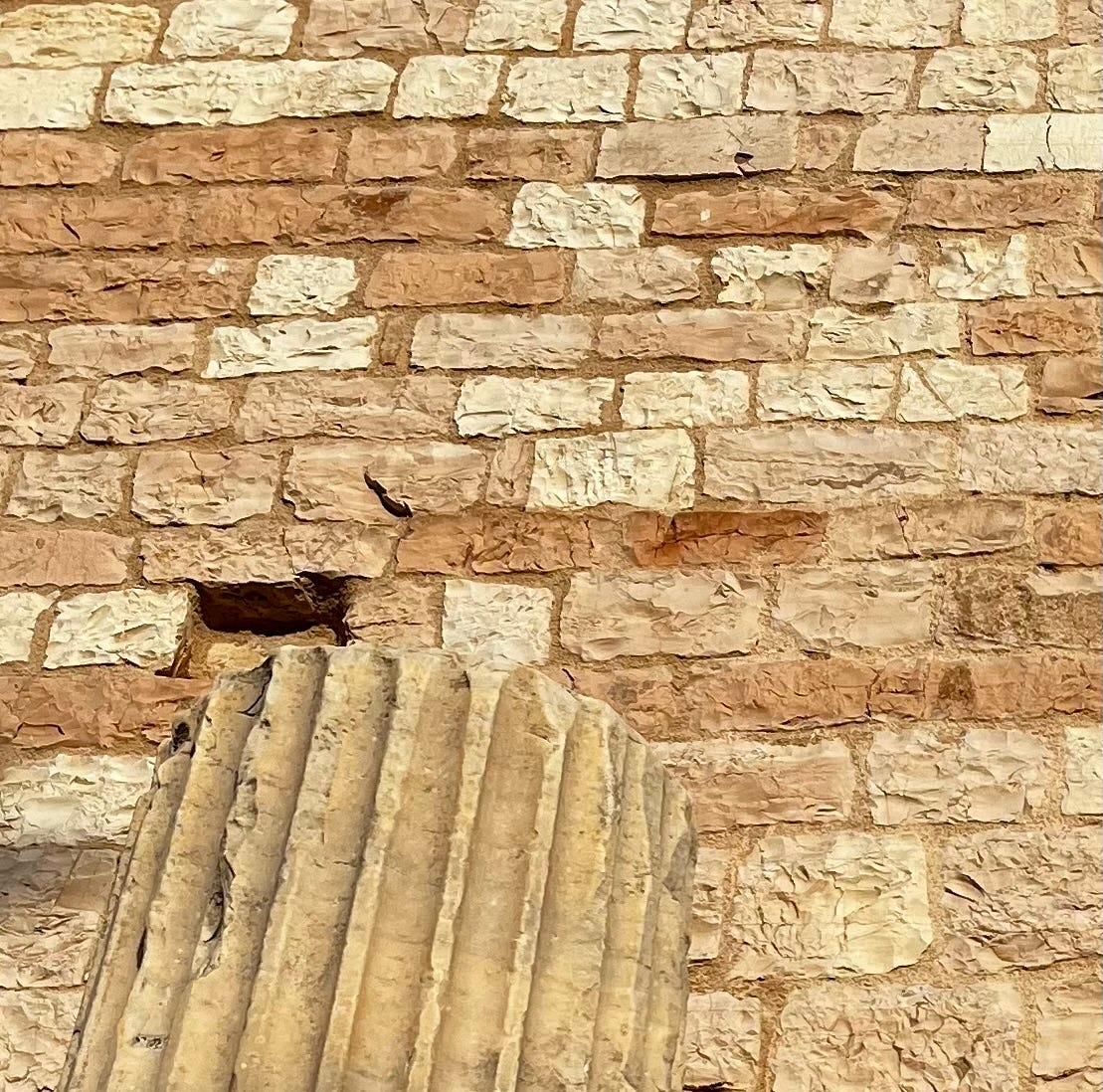
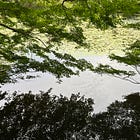
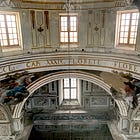
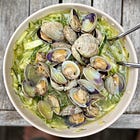
Nice! Did you ever think WHY they built these hilltop towns, and chose to live inside? These picturesque middle-age towns are nice to visit and even live inside, for a short while. Then you realize how difficult and impractical this life is: lack of space, lack of green (all is stone), and contrarily to what it seems, most windows point to narrow streets rather than beautiful vistas. So all you get to see is neighbor’s wall and the rooms are often dark. Then, if I imagine people spending all their lives in one of those towns, I feel this is difficult life. (I don’t mind Italy, but isn’t it so much nicer in a small house with garden?) Yet people chose this life. Why?
My heart is being recharged with the magic of Spello reading your words and seeing it again through your eyes! Thank you for being a momentary member of our community and for sharing your slowing down experience in our little village. Spello is a magical place and it was such a joy to meet you and Daniel here! You’ll always have a home in Spello.